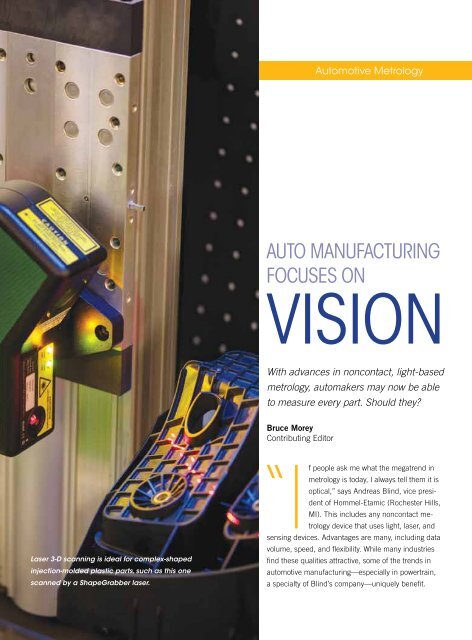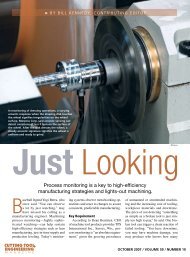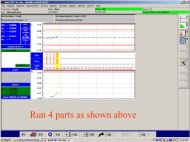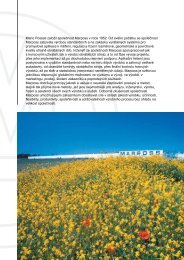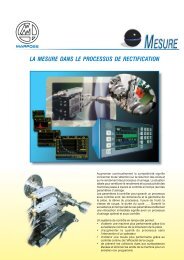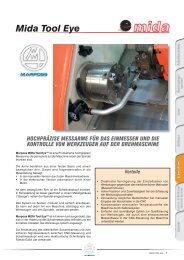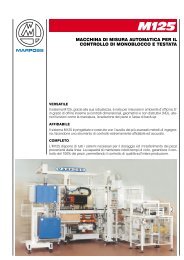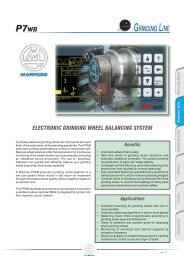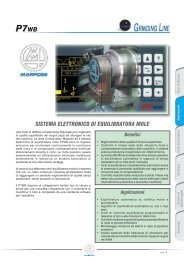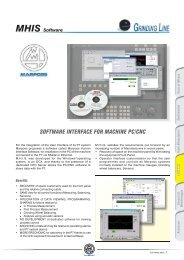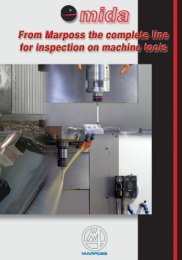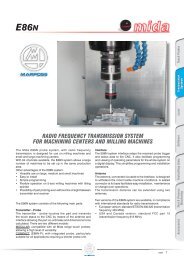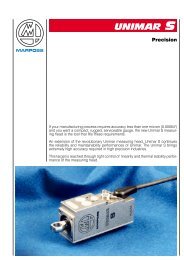Auto Manufacturing Focuses on Vision - Marposs
Auto Manufacturing Focuses on Vision - Marposs
Auto Manufacturing Focuses on Vision - Marposs
You also want an ePaper? Increase the reach of your titles
YUMPU automatically turns print PDFs into web optimized ePapers that Google loves.
Laser 3-D scanning is ideal for complex-shaped<br />
injecti<strong>on</strong>-molded plastic parts, such as this <strong>on</strong>e<br />
scanned by a ShapeGrabber laser.<br />
With advances in n<strong>on</strong>c<strong>on</strong>tact, light-based<br />
metrology, automakers may now be able<br />
to measure every part. Should they?<br />
Bruce Morey<br />
C<strong>on</strong>tributing Editor<br />
<str<strong>on</strong>g>Auto</str<strong>on</strong>g>motive Metrology<br />
<str<strong>on</strong>g>Auto</str<strong>on</strong>g> MAnufActuring<br />
focuses <strong>on</strong><br />
Visi<strong>on</strong><br />
people ask me what the megatrend in<br />
“If<br />
metrology is today, I always tell them it is<br />
optical,” says Andreas Blind, vice president<br />
of Hommel-Etamic (Rochester Hills,<br />
MI). This includes any n<strong>on</strong>c<strong>on</strong>tact metrology<br />
device that uses light, laser, and<br />
sensing devices. Advantages are many, including data<br />
volume, speed, and flexibility. While many industries<br />
find these qualities attractive, some of the trends in<br />
automotive manufacturing—especially in powertrain,<br />
a specialty of Blind’s company—uniquely benefit.
<str<strong>on</strong>g>Auto</str<strong>on</strong>g>motive Metrology<br />
Why? One fact Blind notes is that automotive manufactur-<br />
ers today face uncertain producti<strong>on</strong> volumes with roller coaster<br />
demand, up <strong>on</strong>e year, down the next. There are also shorter<br />
producti<strong>on</strong> runs al<strong>on</strong>g with faster product development cycles.<br />
With part runs dropping into the 100,000s today from milli<strong>on</strong>s<br />
in the old days, manufacturers are striving to make their<br />
lines as flexible as possible. At the same time, there is a push<br />
for tighter tolerances, driven by everything from aesthetics<br />
for bodywork to better fuel efficiency in engines. “<str<strong>on</strong>g>Auto</str<strong>on</strong>g>motive<br />
manufacturers are competing <strong>on</strong> quality more than ever,<br />
driving advances in producti<strong>on</strong> metrology,” he explains. Where<br />
purpose-built hard gaging could be cost-effective over l<strong>on</strong>g<br />
producti<strong>on</strong> runs, this is not necessarily the case anymore. In<br />
resp<strong>on</strong>se, the company is expanding its offerings in fast and<br />
flexible optical metrology, to supplement rather than replace<br />
gaging using pneumatic sensors and tactile probes.<br />
The company is also exploiting a somewhat limited definiti<strong>on</strong><br />
of what automakers mean by flexible.<br />
There’s Flexible and Then There’s Flexible<br />
“They want flexible, but not necessarily a [cylinder] head<br />
today and [an engine] block tomorrow. They want flexibility<br />
within certain, standard limitati<strong>on</strong>s,” he says. “They want variati<strong>on</strong>s<br />
within a standard product portfolio.” A good example<br />
of how Hommel-Etamic exploits this is its Opticline series of<br />
optical metrology systems. Designed to measure l<strong>on</strong>g, round<br />
workpieces such as crankshafts, camshafts, and drive shafts,<br />
these systems operate directly <strong>on</strong> the producti<strong>on</strong> floor. An LED<br />
light source illuminates a shaft rotating between centers while<br />
a high-resoluti<strong>on</strong> CCD line sensor captures the silhouetted<br />
shadow, digitally measuring the c<strong>on</strong>tour as the piece rotates.<br />
Designed for 100% inspecti<strong>on</strong>, it measures diameters to 2 +<br />
D/100 µm and lengths to 5 + L/100 µm, both to ISO 10360.<br />
The Opticline C800 series measures workpieces with a diameter<br />
of up to 140 mm, a length of up to maximum 850 mm<br />
and that weigh up to 20 kg.<br />
Blind also points out that—even as optical n<strong>on</strong>c<strong>on</strong>tact<br />
sensing is becoming mainstream—there is still resistance<br />
from a significant segment of manufacturing professi<strong>on</strong>als.<br />
Engineers are familiar with hard gaging, master artifacts, and<br />
gage R&R studies using such devices. “There is a problem<br />
with standards in optical sensing. To use a known artifact, to<br />
find the ranges and run a repeatability study—it is quite different<br />
with an optical system,” he says. In additi<strong>on</strong>, occasi<strong>on</strong>ally<br />
the cost to clean parts to prepare them for optical gaging can<br />
become a factor. However, the flexibility and speed of optical<br />
gaging offers an unparalleled tool for quality measurement<br />
and evaluati<strong>on</strong> of complex parts as well as for manufacturing<br />
process c<strong>on</strong>trol, Blind says.<br />
Castings are another ideal part for n<strong>on</strong>c<strong>on</strong>tact sensing<br />
and 3-D imaging. Measuring is often d<strong>on</strong>e <strong>on</strong> the producti<strong>on</strong><br />
floor near the point of manufacture, though statistical<br />
sampling remains the norm in automotive parts.<br />
The increasingly complex, organic shapes of automotive<br />
parts is another challenge that n<strong>on</strong>c<strong>on</strong>tact metrology is well<br />
suited for. “There are many drivers for this,” explains Pierre<br />
‘Pete’ Aubrey, president and CEO of ShapeGrabber (Ottawa,<br />
ON, Canada). “C<strong>on</strong>sumers want better erg<strong>on</strong>omics and more<br />
pleasing aesthetics in their vehicles, which leads to more<br />
complex-shaped and curved parts. There is also the driver of<br />
better fuel ec<strong>on</strong>omy, so as cars get smaller and more parts<br />
get put <strong>on</strong> the engine, the engine compartment is getting<br />
more packed with comp<strong>on</strong>ents in a small space.” In additi<strong>on</strong>,<br />
advances in CAD/CAM and multiple-axis machining are giving<br />
automakers the ability to make complex, compound curved<br />
parts. “In a way, they do it because they can,” he remarks.<br />
Measuring such parts with traditi<strong>on</strong>al methods may<br />
not capture all the data needed, particularly if the part has<br />
compound curves, multiple features, and other organic<br />
shapes. Enter 3-D laser scanners like the ShapeGrabber line<br />
of systems in various sizes. The largest can handle parts up<br />
to 4' (1.2 m), such as body panels or car doors. The laser<br />
scanner is enclosed in a cabinet and is used by producti<strong>on</strong><br />
pers<strong>on</strong>nel. Aubrey notes that <strong>on</strong>e <strong>on</strong>ly needs to put a part <strong>on</strong><br />
the scanning machine and ensure that it is stati<strong>on</strong>ary during<br />
Photo courtesy Faro
<str<strong>on</strong>g>Auto</str<strong>on</strong>g>motive Metrology<br />
data capture. ShapeGrabber does not require special, precise,<br />
locator fixturing because the alignment to datums is handled<br />
in post-processing software using the CAD model of the part.<br />
“The system is ideal for plastic injecti<strong>on</strong> molded parts, castings,<br />
and stampings,” he says. These are parts with complex,<br />
blended curves in today’s vehicles. This is where a 3-D scanner<br />
is ideal with its ability to deliver measurements starting at<br />
± 0.001" (0.025 mm) of uncertainty.<br />
<str<strong>on</strong>g>Auto</str<strong>on</strong>g>mating the Scanning<br />
“It has become easy to implement a 3-D scanner like ours<br />
because automating the scanning and post-processing allows<br />
n<strong>on</strong>experts to use it,” Aubrey says. He points out the software<br />
used with the system can help with SPC collecti<strong>on</strong> and analysis.<br />
ShapeGrabber has interfaces to most metrology packages,<br />
in particular industry leaders Geomagic (Morrisville, NC) and<br />
PolyWorks from Innovmetric (Quebec, QC, Canada).<br />
<str<strong>on</strong>g>Auto</str<strong>on</strong>g>mati<strong>on</strong>, such as this robotically operated WL400 white<br />
light system, provides opti<strong>on</strong>s and choices for measuring<br />
near or <strong>on</strong> the producti<strong>on</strong> line, especially when the<br />
manufacturing line moves from the prove-out stage<br />
to full run-at-rate.<br />
“Our sweet spot in the market place is with Tier 2 suppliers—folks<br />
making smaller parts that are assembled into<br />
vehicles,” Aubrey says. He makes no secret that his company<br />
is competing with traditi<strong>on</strong>al fixed or hard gages still comm<strong>on</strong><br />
in this segment of the industry. Although individual gages<br />
may be cheaper, and sometimes faster, he also notes they<br />
take <strong>on</strong>ly six to 12 measurements per part, and <strong>on</strong>e gage is<br />
needed for each part produced. In c<strong>on</strong>trast, a ShapeGrabber<br />
scanner used with the metrology software is a virtual gage,<br />
which is much more flexible. “Hard gages are quite limited in<br />
scope and can’t handle ‘inspecti<strong>on</strong> creep,’” he says. This is<br />
the increase of producti<strong>on</strong> measurement requirements over<br />
time, usually due to unforeseen problems and/or rejects down<br />
the line. It is much easier to modify a virtual gage than to<br />
redesign and retrofit a hard gage.<br />
“Optoelectr<strong>on</strong>ic systems are far more flexible than hard<br />
gaging, but there are tradeoffs,” agrees Roger Zeoli, product<br />
manager for <strong>Marposs</strong> Corp. (Auburn Hills, MI). His company<br />
also sees the value in flexible metrology with its n<strong>on</strong>c<strong>on</strong>tactbased<br />
Optoquick and Optoflex systems. Both systems use<br />
shadow cast technology in a closed cabinet. Again, designed<br />
for the shop floor, manufacturers could integrate them into a<br />
producti<strong>on</strong> line or use them as an audit stati<strong>on</strong>, or as a postprocess<br />
inspecti<strong>on</strong>. The Optoquick comes in either horiz<strong>on</strong>tal<br />
or vertical layouts. Designed for shaft-like parts like crankshafts<br />
and camshafts, they both feature a universal reference master<br />
located in the machine, with a self-zeroing cycle. Similar to<br />
other systems, the number of parts that could be measured is<br />
limited <strong>on</strong>ly by their physical size and weight. The Optoquick<br />
measures parts up to 750 mm in length and from 0 to 155 mm<br />
in diameter (measurable.) The M110 Optoflex measures parts<br />
up to 800 mm in length and 200 mm in diameter. Both boast<br />
measuring uncertainties of less than 2 µm for diameters and<br />
less than 6 µm in length. The systems offer Statistical Process<br />
C<strong>on</strong>trol (SPC) software <strong>on</strong> both models for analyzing measurements<br />
at the stati<strong>on</strong>.<br />
Measuring programs are stored electr<strong>on</strong>ically and selected for<br />
each part. There could be many parts. “Parts are limited <strong>on</strong>ly by<br />
their size,” says Zeoli. He too offers cauti<strong>on</strong>s about unbounded<br />
or unwarranted noti<strong>on</strong>s of flexibility. While the data volumes and<br />
accuracies these machines deliver are impressive, there is still<br />
a place for hard gaging with traditi<strong>on</strong>al touch probes or linear<br />
variable differential transformer sensors, according to Zeoli. For<br />
example, the Optoquick measures in the axial directi<strong>on</strong> at 20<br />
mm/sec and angularly at 1.5 revoluti<strong>on</strong>s/sec. Impressive speed<br />
with thousands, even milli<strong>on</strong>s of data points. However, Zeoli<br />
points out that hard gaging can be much faster. Admittedly, they<br />
take far fewer measurement points. However, they are accurate<br />
and take less than 30 sec<strong>on</strong>ds for similar parts, while it may take<br />
minutes to measure a whole shaft optically, he adds.<br />
Design and Producti<strong>on</strong><br />
<str<strong>on</strong>g>Auto</str<strong>on</strong>g>mati<strong>on</strong> is a key element for n<strong>on</strong>c<strong>on</strong>tact metrology.<br />
Nik<strong>on</strong> Metrology (Bright<strong>on</strong>, MI) provides a number of laser<br />
scanner and optical systems for use in automotive design studios,<br />
research centers, and pilot plants as well as in producti<strong>on</strong><br />
plants. “For producti<strong>on</strong> inspecti<strong>on</strong>, you want something
<str<strong>on</strong>g>Auto</str<strong>on</strong>g>motive Metrology<br />
that is as automatic as possible,” explains Alex Lucas, product<br />
manager for Nik<strong>on</strong> Metrology. “We deliver many dual-arm<br />
CMMs al<strong>on</strong>g with our CMM-based laser scanners for those<br />
applicati<strong>on</strong>s. The laser scanner provides advantages in speed,<br />
high accuracy, and ease of programming and use.” A typical<br />
dual-arm CMM include Nik<strong>on</strong>’s LK H brand, such as the LK<br />
H-R with rail lengths from 4 to 10 m or more. While equipped<br />
standard with a PH10MQ touch probe, these horiz<strong>on</strong>tal-arm<br />
CMMs can also be equipped with <strong>on</strong>e of Nik<strong>on</strong>’s laser scan<br />
heads. “The most popular is the XC65Dx-LS,” notes Lucas. “I<br />
estimate it is at least 75% of all scanners we sell into producti<strong>on</strong><br />
inspecti<strong>on</strong> for automotive applicati<strong>on</strong>s.”<br />
The XC65Dx-LS uses a cross pattern of three laser stripes,<br />
acquiring a better 3-D view when scanning parts with more<br />
complex surface shapes and better able to detect holes and<br />
edges. Its measuring uncertainty is 20 µm to 1σ within a 3 ×<br />
65-mm field of view. “The real advantage of that over other<br />
CMM scanning products is the l<strong>on</strong>g standoff distance of<br />
170 mm. That is where LS comes from,” says Lucas. This is<br />
the maximum distance the sensor head can be away from<br />
the surface it is measuring. This provides better maneuverability<br />
and makes it easier to program the CMM. “We can<br />
also deliver this <strong>on</strong>to third-party CMMs; we are not limited to<br />
Nik<strong>on</strong> equipment,” remarks Lucas. Ideal for sheetmetal and<br />
stamped parts, he notes customers are using the XC65Dx-LS<br />
to measure parts ranging from individual comp<strong>on</strong>ents all the<br />
way to entire bodies-in-white.<br />
He notes that few customers want to exploit the increased<br />
speed of scanning for 100% inspecti<strong>on</strong>. Most, if not all,<br />
prefer to remain with a statistical sampling for producti<strong>on</strong><br />
and process c<strong>on</strong>trol. “3-D scanning provides the capability<br />
to measure parts fully. You can compare the measurements<br />
with CAD to produce full color, 3-D renditi<strong>on</strong>s of deviati<strong>on</strong>s.<br />
However, producti<strong>on</strong> people are not that interested in that,”<br />
he says, remaining the domain of research labs or engineers<br />
engaged in troubleshooting of designs or process. “What most<br />
want is to quickly get data they need to track their processes.<br />
So we have many customers who replace a touch trigger<br />
probe with a laser and sample just a few areas with what<br />
might be termed targeted laser scanning and reduce the data<br />
down to specific (x-y-z) points for comparis<strong>on</strong>s,” he explains.<br />
This delivers faster measuring cycles, usually between 50%<br />
and 70% faster. He also believes that large-scale plastic<br />
comp<strong>on</strong>ents, such as instrument panels, are becoming more<br />
interesting for this targeted laser scanning approach, especial-<br />
ly involving soft materials that might be deflected by a touch<br />
or scanning analog probe.<br />
White Light Systems<br />
White light<br />
systems are<br />
another device<br />
that offers widearea<br />
scanning for<br />
n<strong>on</strong>c<strong>on</strong>tact metrology.<br />
Under the<br />
Cognitens brand,<br />
Hexag<strong>on</strong> Metrology<br />
(North Kingstown,<br />
RI) offers white<br />
light (now actually<br />
blue) sensors for<br />
3-D measurements<br />
ideal for automotive<br />
bodywork. Using<br />
fringe patterns,<br />
these n<strong>on</strong>c<strong>on</strong>tact/<br />
visi<strong>on</strong> systems<br />
capture data in<br />
up to 500 × 500<br />
mm tiles, delivering<br />
measurement<br />
accuracy for a<br />
<strong>on</strong>e-meter volume<br />
at about 25 µm to<br />
Fully enclosed cabinets c<strong>on</strong>taining<br />
2 σ, according to<br />
optical measuring devices are<br />
Cliff Bliss, nati<strong>on</strong>al<br />
ideal for placing near or <strong>on</strong> the<br />
manager for Cog-<br />
producti<strong>on</strong> floor.<br />
nitens. There is a<br />
manual opti<strong>on</strong>, the WLS400M, and an automated system, the<br />
WLS400A, that work with off-the-shelf robots. Their market<br />
niche is bigger parts as well, body stampings and bodies-inwhite,<br />
according to Bliss.<br />
Bliss sees a difference in how the systems are used. “Historically,<br />
the manual system has sold better than the automated<br />
system, but I see that changing as time goes <strong>on</strong>,” he says.<br />
Manual systems have proven themselves in assembly proveouts,<br />
tool try-outs, and the general development process in<br />
manufacturing. Tooling and dies for stampings are measured<br />
meticulously during initial first shots, where engineers tune in<br />
Photo courtesy Hommel-Etamic America
Photo courtesy <strong>Marposs</strong><br />
<str<strong>on</strong>g>Auto</str<strong>on</strong>g>motive Metrology<br />
the die prior to full-run producti<strong>on</strong>. They find their use in slow<br />
builds, often used to prove-out assembly procedures prior to<br />
ramping up to run-at-rate. Typically, at this stage, much of a<br />
part is checked and color maps of deviati<strong>on</strong>s are created. All<br />
parts are checked at this stage.<br />
C<strong>on</strong>stricting measurements to a class of objects, such<br />
as shaft-like objects, is a way for automakers to use<br />
equipment in a way that is flexible for their needs while<br />
maintaining speed and accuracy.<br />
“The automated systems are used when they transiti<strong>on</strong> to<br />
steady-state producti<strong>on</strong>, and we are seeing a definite ramp-up<br />
in both inquiries and sales for the WLS400A,” reports Bliss.<br />
At this stage, he also sees that fewer elements of the part<br />
are measured. Sampling replaces 100% inspecti<strong>on</strong> and SPC<br />
software, such as Hexag<strong>on</strong>’s CoreView Pro is used to analyze<br />
and present results.<br />
A New Twist <strong>on</strong> White Light<br />
Another, relatively new, white light area sensor for metrol-<br />
ogy is the Faro AMP 3-D imaging system. It exploits Accordi<strong>on</strong><br />
Fringe Interferometry (AFI) and measures data over a 500<br />
× 500 × 220-mm field of view to 65 µm of uncertainty as<br />
SEPTEMBER 2012<br />
measured to the VDI/VDE 2634 part 2 specificati<strong>on</strong>, according<br />
to Chuck Pfeffer, director of product management, Faro Technologies<br />
Inc. (Lake Mary, FL). Like white light systems, the<br />
AMP is ideal for measuring large parts such as body panels as<br />
well as the dies that make them. He reports the AMP system<br />
is also used in proving out a stamping process prior to run-atrate<br />
for body panels and car bodies.<br />
Pfeffer particularly notes that the AMP is often used in<br />
casting operati<strong>on</strong>s. “They use the AMP to measure both the<br />
molds used for casting and the cast parts themselves,” he explains.<br />
Many cast parts go <strong>on</strong> to finish machining, where they<br />
use the AMP sensor to measure the casting before machining,<br />
according to Pfeffer. They map each casting to determine<br />
variati<strong>on</strong>s in actual wall thickness, using that data to fine<br />
tune the subsequent machining process. They use the AMP<br />
system right <strong>on</strong> the producti<strong>on</strong> floor since it was designed to<br />
be stable and robust. An opti<strong>on</strong> for the AMP is automati<strong>on</strong>.<br />
Some manufacturers, according to Pfeffer, measure cast parts<br />
with 100% inspecti<strong>on</strong> before machining, though he notes that<br />
is infrequently d<strong>on</strong>e in automotive. “They usually measure<br />
100% for a run until they’re comfortable with the process,<br />
letting them find out if the casting process has a problem,”<br />
he says. After that, they c<strong>on</strong>tinue to use the system through<br />
sampling products and SPC.<br />
What is in store next? “The automotive industry has dabbled<br />
in 3-D scanning in the past, mostly in design and design labs.<br />
Some of the big OEMs have been using it in assembly inspecti<strong>on</strong>.<br />
Now, I see a big push from the Tier 1 and Tier 2s to<br />
implement 3-D scanning as the basic way to inspect their parts.<br />
That is going to be happening in this decade—for all scanning<br />
systems,” says ShapeGrabber’s Aubrey. There is also untapped<br />
potential in the data that these systems provide. “When they go<br />
into producti<strong>on</strong>, they gather metrology data and use it to determine<br />
pass/fail criteria <strong>on</strong> parts. Only when they detect a failure<br />
do they look at the data,” says Bliss. “But there is a whole<br />
universe of how to use that data, from preventive maintenance<br />
to even using it to fine-tune finite-element analysis.” Although<br />
some groups use the data outside the narrow use of metrology,<br />
according to Bliss, a more comprehensive look at the data<br />
could unlock much more value. ME<br />
Copyright Notice: 2012 Copyright by SoCiety of ManufaCturing engineerS. all rightS<br />
retained. thiS artiCle May <strong>on</strong>ly be viewed or printed <strong>on</strong>e (1) tiMe for perS<strong>on</strong>al uSe.<br />
uSer May not Save any text or graphiCal iteMS to hard driveS or dupliCate thiS<br />
artiCle in whole or in part in any MediuM. thiS artiCle appearS with perMiSSi<strong>on</strong><br />
froM ManufaCturing engineering®, the offiCial publiCati<strong>on</strong> of the SoCiety of<br />
ManufaCturing engineerS (SMe). www.SMe.org.”


